And so, we begin. As with most facets of life in the bush, compromise, adaptation, and improvisation are necessary for success. Like skinning all manner of fur in your kitchen, for example. The first thing to do when skinning of course is to tie off to something from which your animal will hang. Something solid and unmoving is preferable, as you will be putting pressure on it when pulling. In this case, I tied off to my beaver fleshing board, which is conveniently mounted on the wall right next to our kitchen table. :) Kid you not, I was once complemented on our "homemade ironing board" by a dinner guest, and then promptly asked, "What is it, then?..." when Sarah and I told her over her plate of spaghetti that it wasn't an ironing board... that memory brings back a belly laugh....
Anyway, here is the Marten, already hung. I just use a simple loop on the end of each piece of string, through which you can pass the main length of string that is hanging down. This creates a variable size, sliding loop that can be put over a hind foot, and will cinch down tight with the weight of the animal.

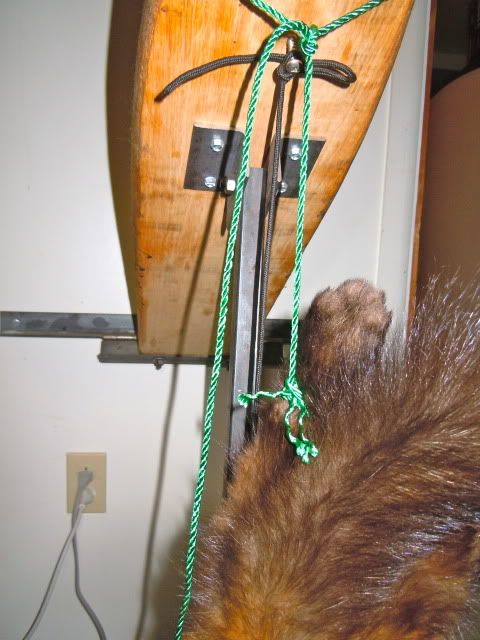
I like to start with just one hind foot tied up, and let the other swing free for a bit, as we will see.
When skinning for fur sale, not taxidermy, the very first cut I make is one that circles the entire back leg in a ring, just before the last joint of the foot (ankle).
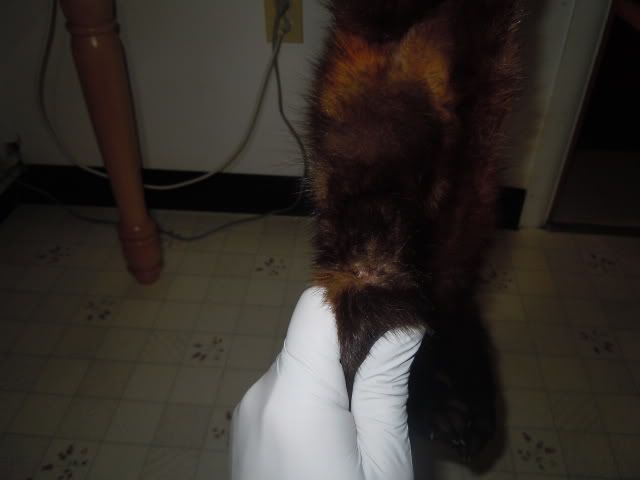
After that first cut is made on each leg, I then get out my utility knife. For the next step I like to use the 'hook-tip' blades, not regular straight razors. They can be found in any hardware store or of course online. These are a GREAT idea for anyone skinning ANYTHING. They work like a zipper.
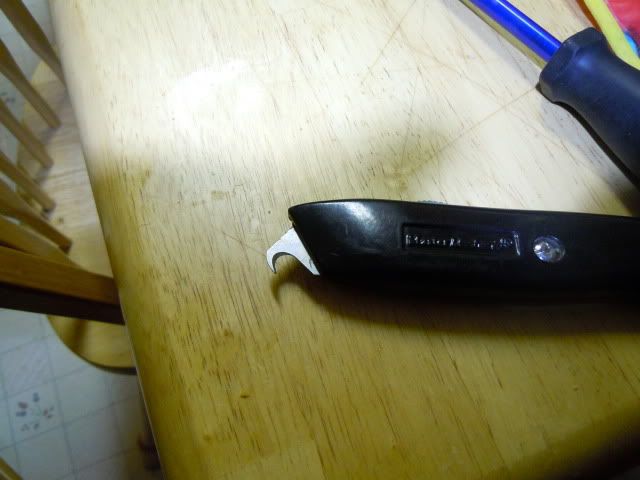
Now - what you want to do is, take the hook knife (or any knife you happen to be using), and make a straight line from the cut you made around the leg, leading towards the anus. Such a line would follow the knife I am holding in this photo.
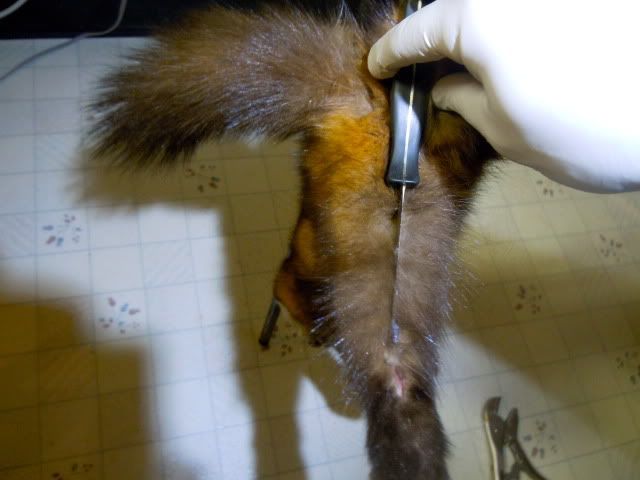
Here is the start of that cut with the hook knife:

And here is a shot after both cuts have been made, one from each ankle leading towards the anus:

***Important*** - I say "towards the anus" rather than "towards the base of the tail", for a reason. In most cases, making this cut cross below the anus (as in, opposite side of the tail, toward the groin area) will extend the length of the fur on the back side, where it will be measured and sized. If you cut right to the anus, or go above it (tail side), you will lose precious length that you can otherwise save yourself, and in the end, get more for your fur. A 22 and 7/8 inch-long Marten skin will be graded a different size by NAFA than a skin that is just over 23 in., in other words.
So, now that those two cuts have been made, it is time to start skinning the two back legs.
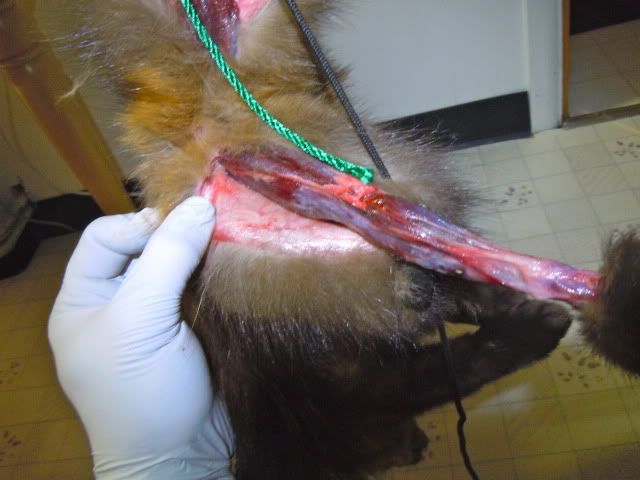

After skinning the two back legs, you will come to a point where you need to cut above and below the anus in order to move forward on skinning the tail and pulling the skin down toward the body.
This pic shows the start of that, with the tail being held pointing toward the camera:
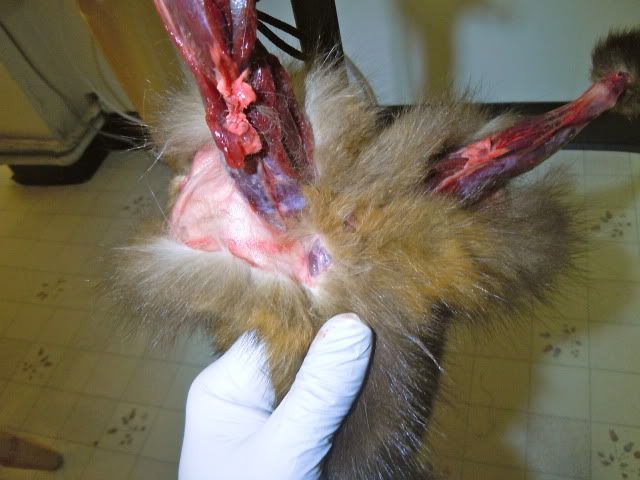
I make a cut straight across the base of the tail. This cut connects the two open spots you created when you skinned out the two legs.
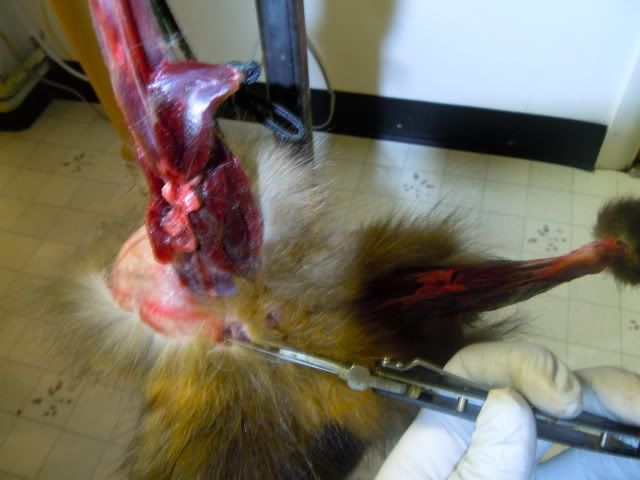
After that cut, you should see something like this:
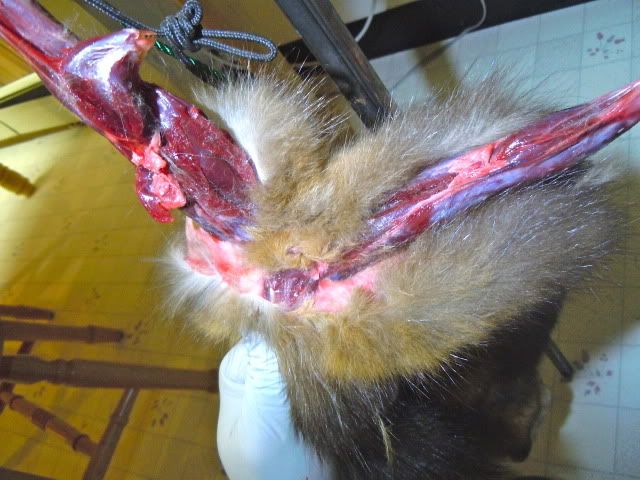
Now, the tail. Again, I use the hook knife here. You will see two white ligaments that run up the sides of the tail within the muscle. Use them as your guide, and make a cut running right up the center of the tail, evenly spaced between these two ligaments.
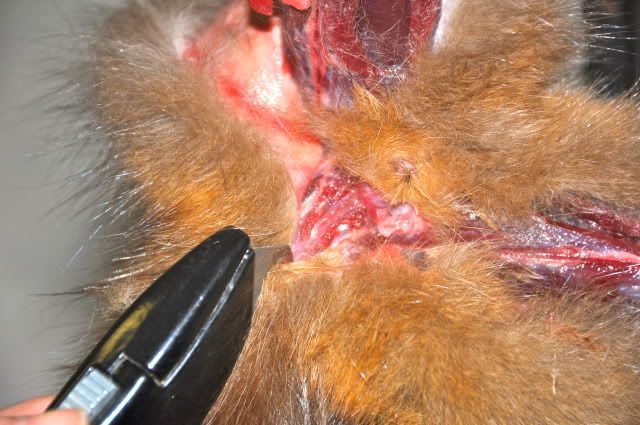

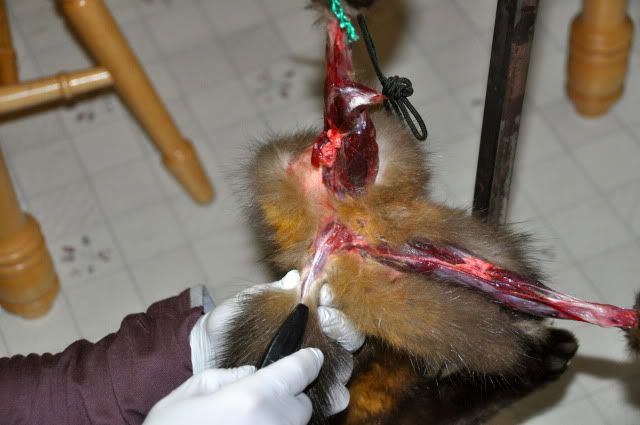
Once you have split the tail, then work along the sides of it with your knife until you can pull it completely free of the fur. Careful!! The skin is thin here!
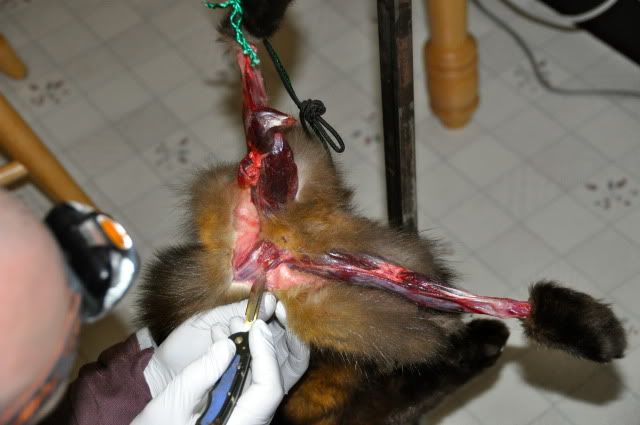
After the tail is free, things get easier. Just use your knife to skin the fur away from the groin area, careful to trim extra fat which usually accumulates here, and then its on to the simplest part of the whole skinning. Now you can just pull down on the hide until you begin to approach the shoulder area. It is there we will pick up with the pics.
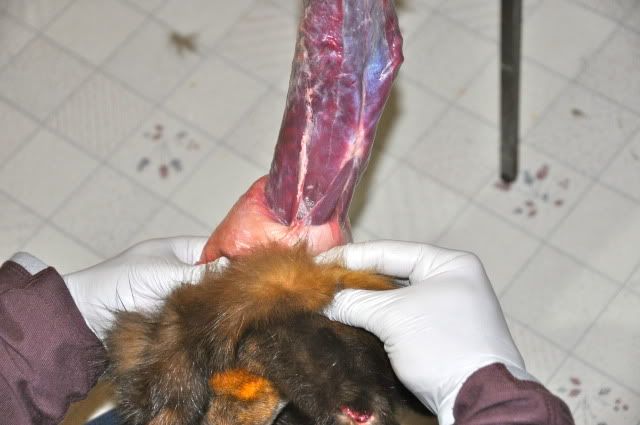
Notice the cut on the front leg at the very bottom of that pic above? When you start to get close to the chest, you will want to make circular cuts around the front legs, just behind the feet, same as you did on the back legs in the beginning. The purpose of this will be shown later. (*Reminder, this is only done when skinning for fur sale, and not taxidermy, in which case the feet/claws will be left on.)
Now, at this point, after the front leg cuts are made, I put my knives down for a while. This next segment is done entirely by hand. The skin around the shoulders and chest is usually very clingy, and it is easy to make a hole if you use a knife, as the line of where to cut can be deceiving. So I don't cut at all. I push and pull with my fingers, sliding them between the muscle and hide to separate the two. The next sequence of pictures will show this. Just keep pushing and pulling, poking with your fingers, turning the animal to work evenly around its front and back side. Very few, if any, cuts will need to be made with a knife at this point, and that will mostly be determined by the state of the animal (cold, still warm, partially frozen, etc).
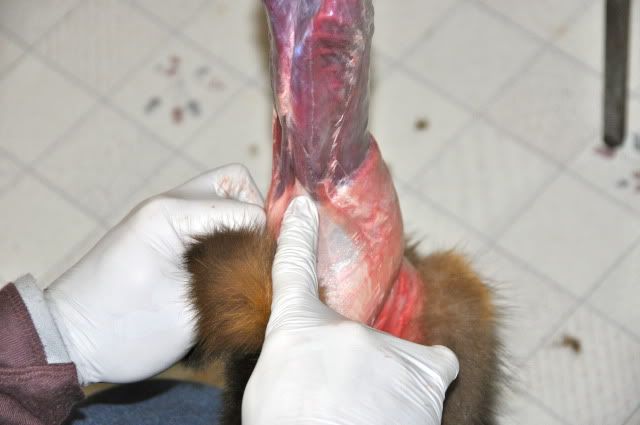
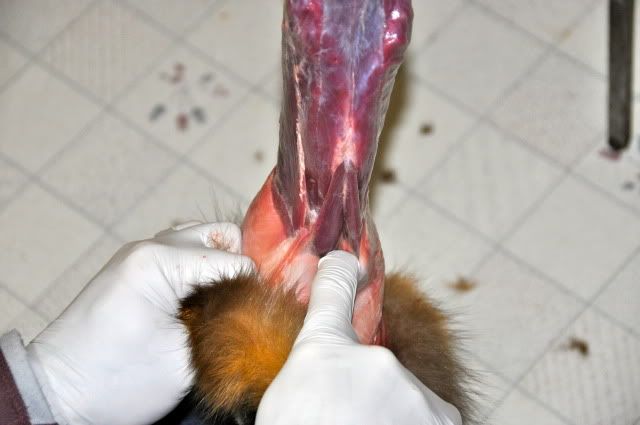
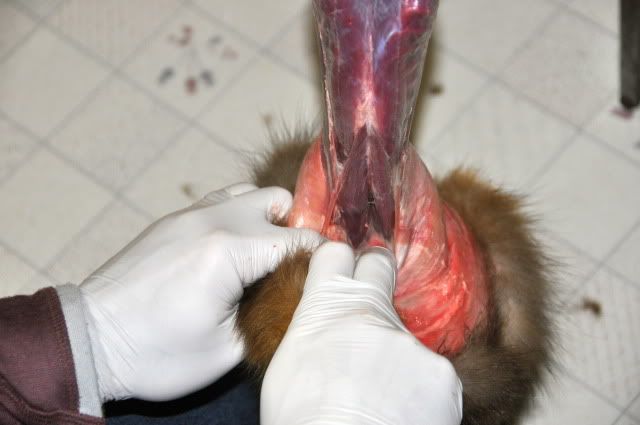

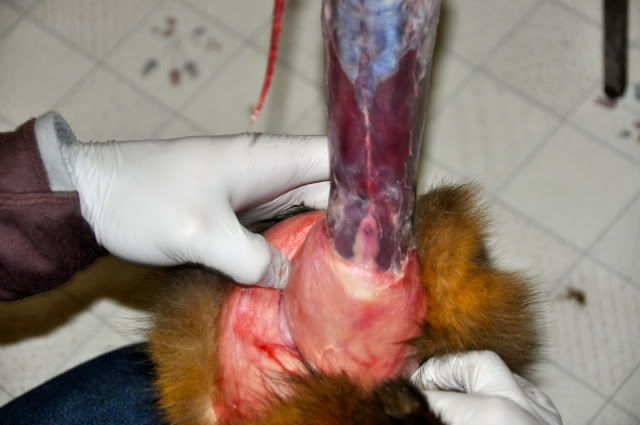
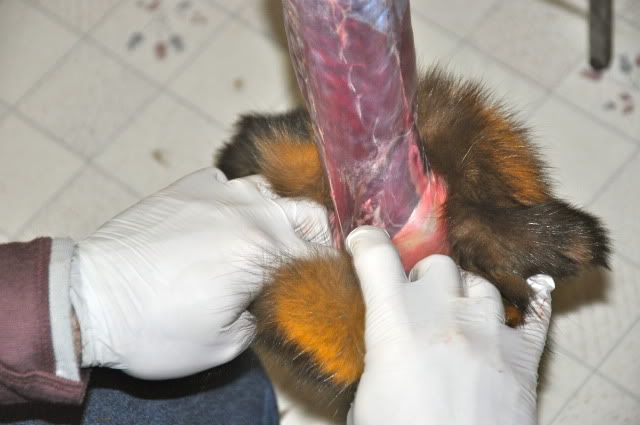
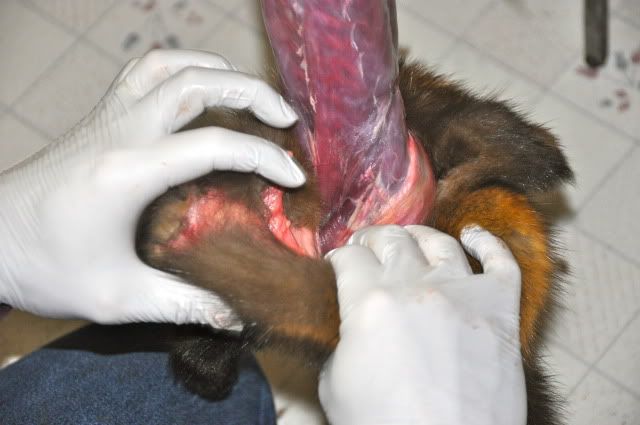
OK. We have worked our way down to the start of where the two front legs protrude from the body.
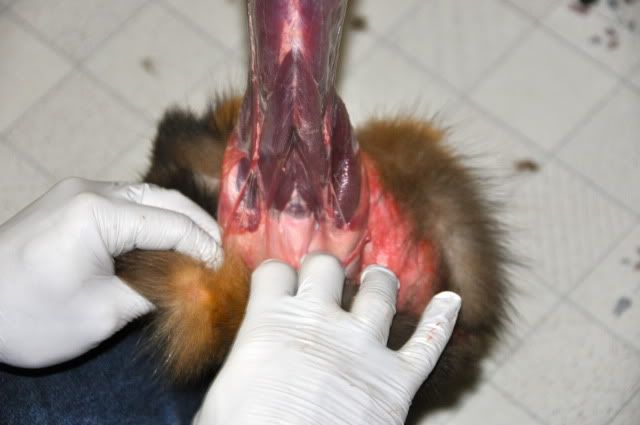
Here they are, in a belly-side view - that is, the leg on the left is the marten's right leg, and vice-versa.
Notice the membranes, still attached, that are connected to both the hide and the muscle on the body. For those, you will want the knives again.
VERY carefully and lightly, you want to cut away this red, fibrous membrane from the hide so that it will stay attached to the muscle and pull away from the hide. Like so:
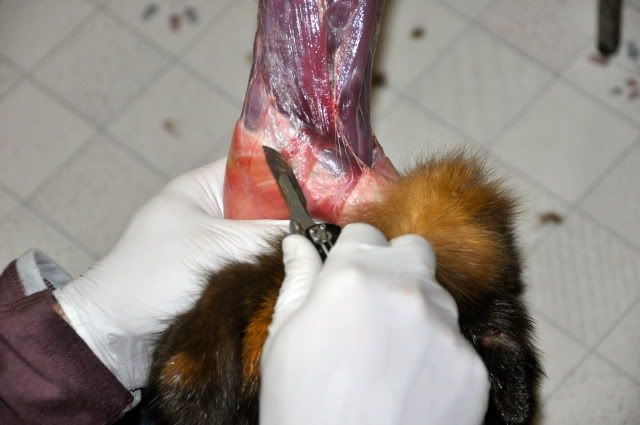

Remember, the more 'stuff' you get off of the hide now, the less you have to trim off later, when the skin is on the stretcher.
Here is a shot of the membrane removal on the other leg:
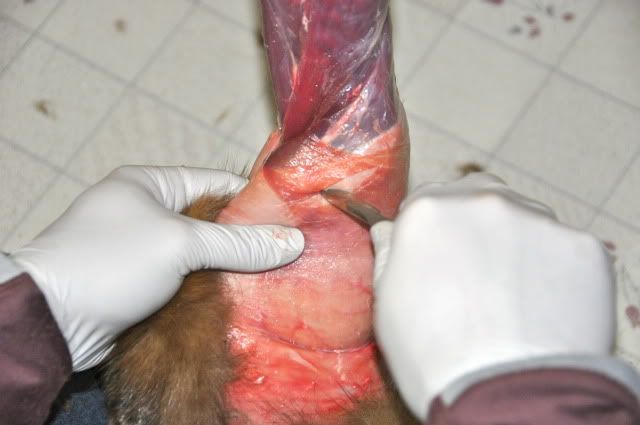
After that, it is finger time again - no knife for a bit. Keep poking and pushing and pulling, working your way completely around the body and both legs. The 'clingiest' stuff will be between the legs in the brisket area, where the hide has to stretch over both legs and the chest. Just keep digging your fingers in between the skin and the meat, and eventually you will keep making progress.
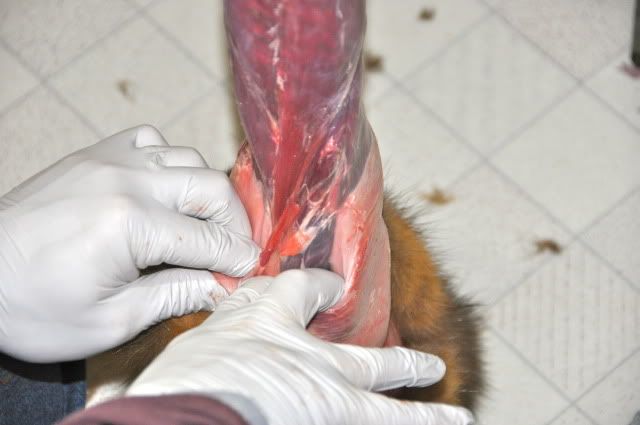
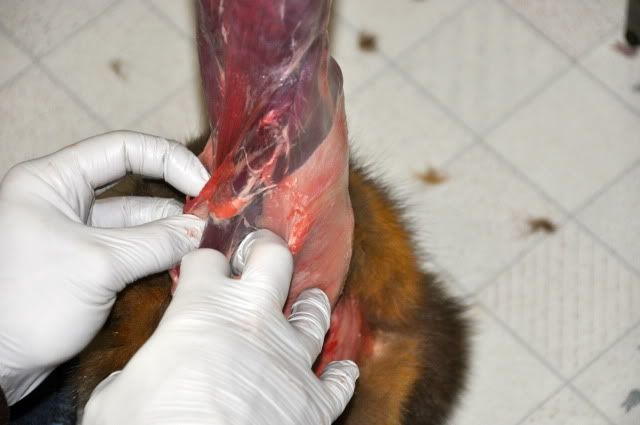
Eventually, you will see that you have pulled the hide down enough to see where the edge of the leg is. At this point, you can stick a pointer finger in between the hide and the meat of the leg and push hard enough to poke through.
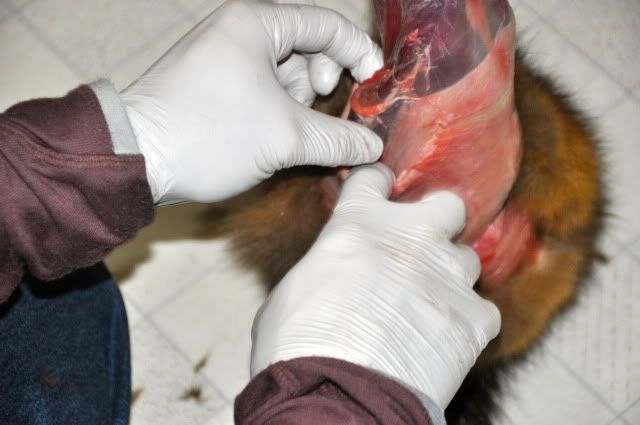
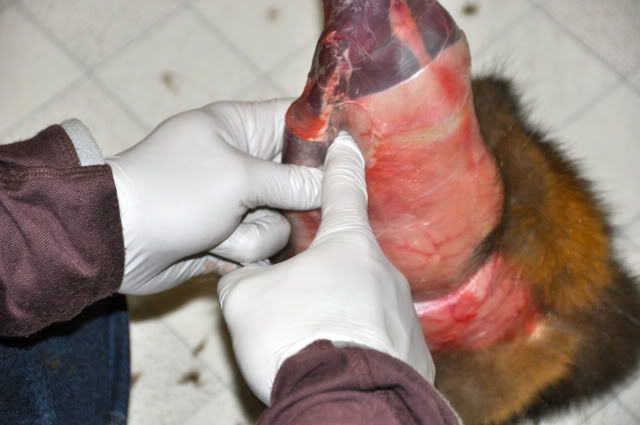

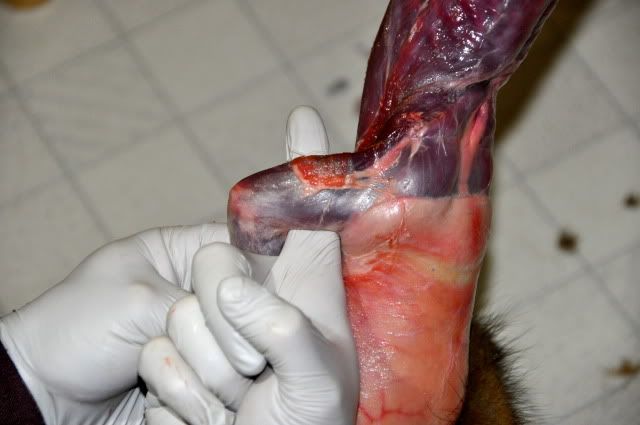
Now you are almost through with the legs!
Once you have poked through, it gets easy to work your finger between the leg and hide and free the leg all the way around, working toward the foot.
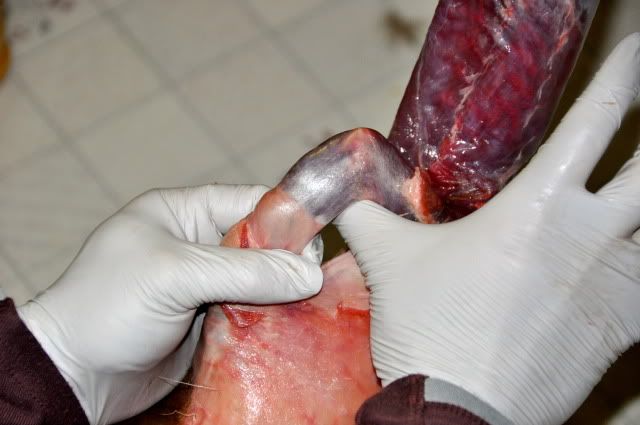
Soon you can grab the leg firmly, hooking your thumb in the crook of the elbow, and pull, using the other hand to separate the hide from the leg. You will feel the leg pulling through the 'tube' of hide as you go:
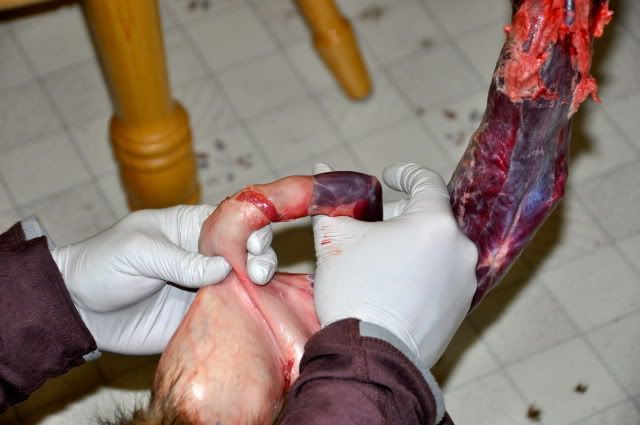

As you get close to freeing the legs, you will notice that the feet - more specifically the claws, which are now on the inside of the 'tube', are capable of tearing the hide as you pull. This is where the cut you made around the base of the foot comes in. The hide is already free there, so that when you pop the foot out of the 'tube', the leg is completely free.
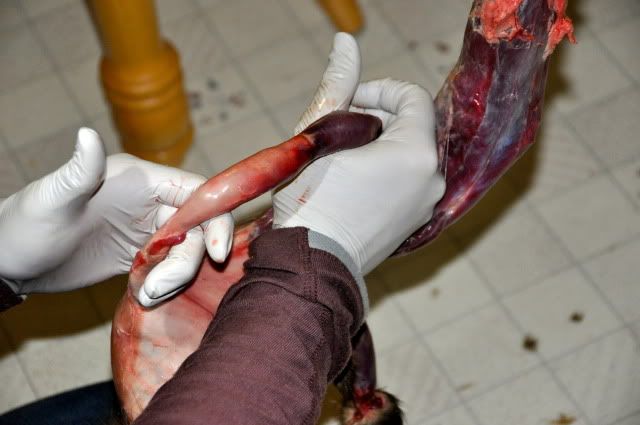
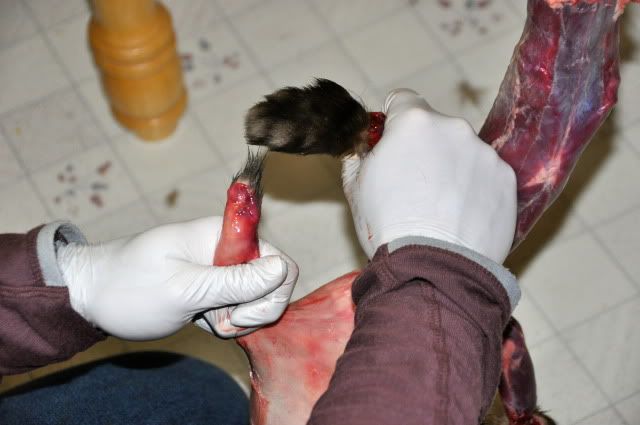
Now, once the legs are free, it is time to pick up the knife again and separate the hide from the shoulders, and then go for the neck and head. We are almost done!
As soon as you uncover part of the neck, you will notice two large blood vessels, one running up each side. DO NOT nick these with the knife, or you will be blotting up blood (possibly wiping up the floor, even) the whole rest of the time. BE CAREFUL around them and use LIGHT pressure with the knife in these areas!!!
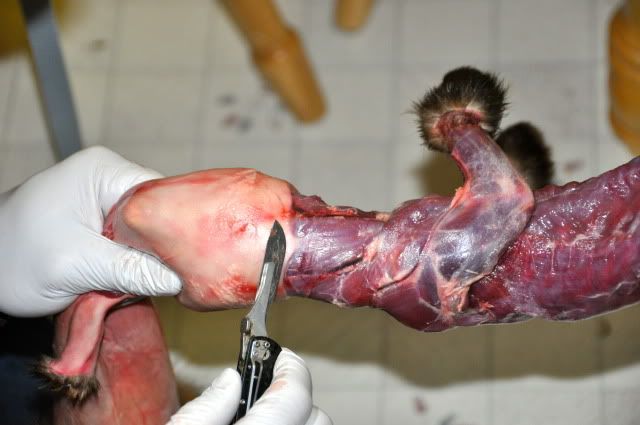

Alright. Now that we are through the neck area safely, we begin to see the head musculature, and not long after that, on a marten, you will notice the start of the ears. These are given away by a pale, off-white, lumpy-looking area. This 'lumpiness' is ear cartilage you are seeing under the layers of tissue. You can confirm this by poking it with a finger, and it will feel spongy. I am pointing to the ear cartilage in this picture:
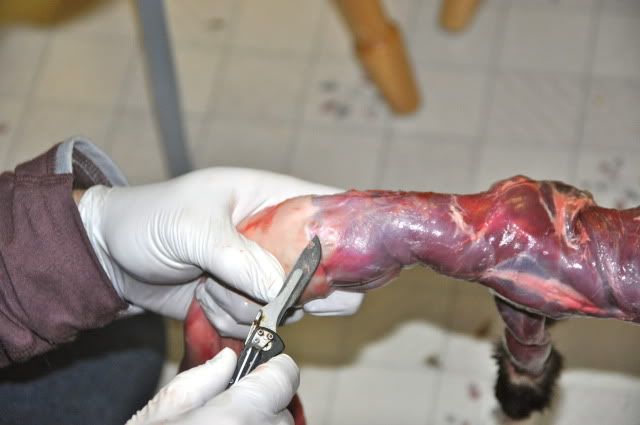
After exposing a bit of this cartilage (I like to leave as much as possible on the head and NOT on the ear skin), you will want to hold the knife at an angle PERPENDICULAR to the head and cut down.

Remember, cut STRAIGHT down into the head, at a PERPENDICULAR angle, or you might cut off some of the ear, which you do not want. Once you are all the way through, the part of the ear that is on the hide makes a nice hole to put a fingertip in and can be used as a great 'hold' to pull with.
When the ears have been separated from their cartilage, it won't be long until you get to the eyes. Again, you will notice a difference in coloration where the eye is lying. In this pic, I am pointing to this 'eyespot' with the knife:
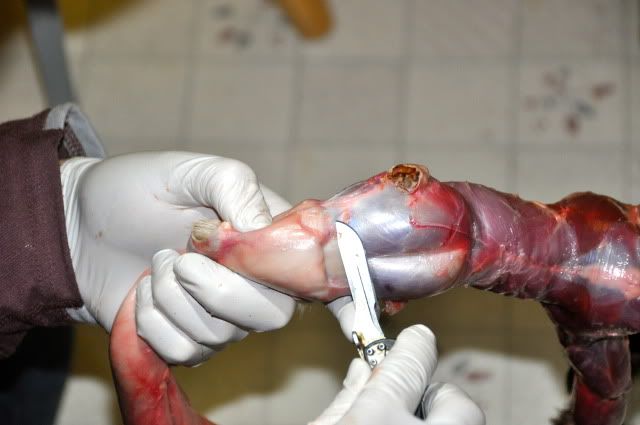
Now, same thing as with the ear - at a PERPENDICULAR angle, cut down into the head while pulling.
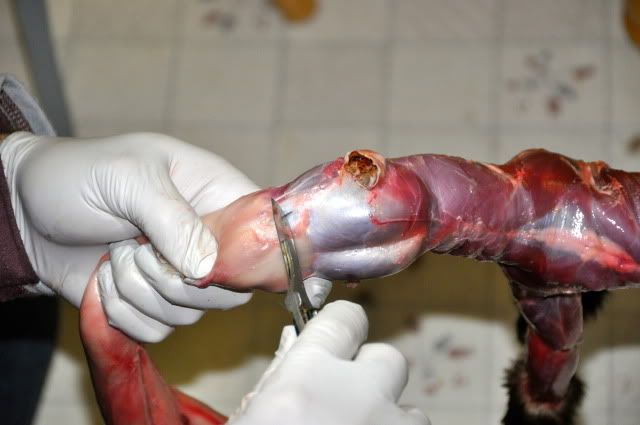
Soon a hole will start to appear, as though you are cutting a hole in the hide. This is just the opening where the eye sits, of course, and you will see the skin start to separate from the eye as the eye now becomes visible when the inside-out skin pulls away from the opening.

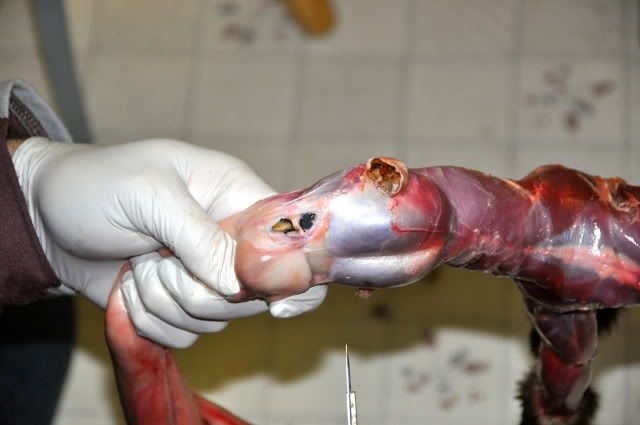
Repeat on the other eye, and now you are down to the bridge of the nose and cheeks/lower jaw area.
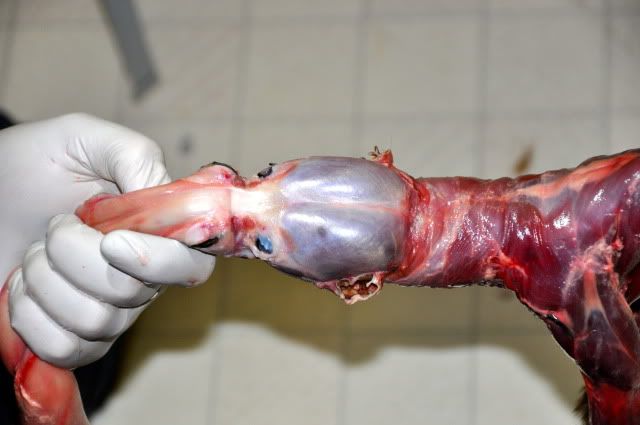
When you make the first cut that lies along the lips, it will again look like you are cutting hole in the hide - only you can see teeth through the hole. This is normal, you are just removing the inside out hide from the jaws. Again, this 'hole' makes a great place to hook a finger in and pull.

Do this on both sides of the jaw, and continue along the bridge of the nose to keep up, turning the head as needed to keep everything coming off evenly.

As you get close to the nose, the tissue will get cartilage-like again, and when it does, you can cut straight down into it, slowly. Upon doing so, you will be able to see the two nasal passages in this cartilage. In the next two pictures, I am pointing to this spot with the knife:
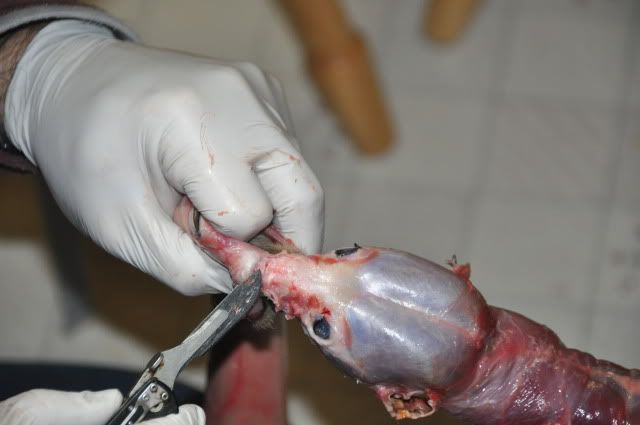
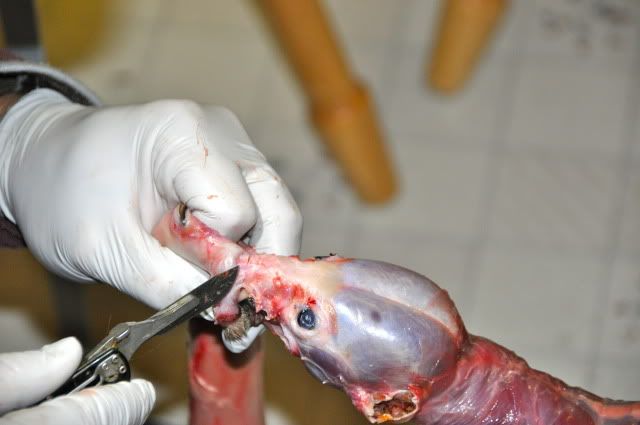
Don't forget to cut STRAIGHT down to remove the nose, not angled back into the hide:
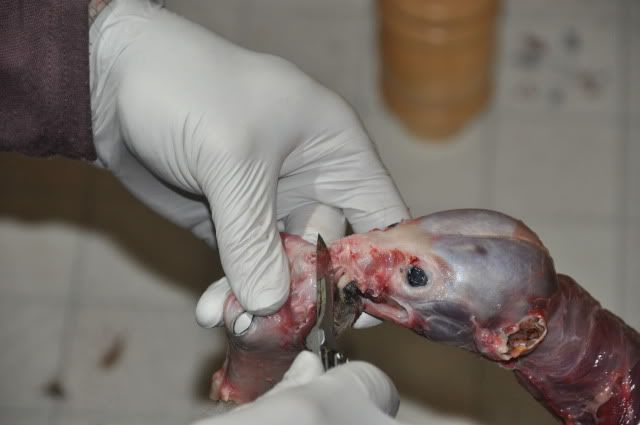
Here is a pic just before the last cut of all, which will completely remove the hide. The two nasal passages in the nose on the hide are clearly seen as two pink holes here:
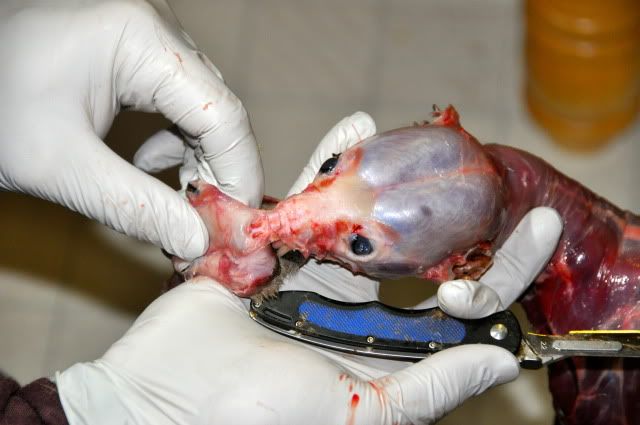
The hide is free!!!!!!!
Now, to the stretcher.
Slide the hide over the stretcher, trying to keep it centered as much as possible. Use the natural edge you have in the upper lip and nose to hook the hide over the point of the stretcher.
Once the nose is 'hooked' on the end of the stretcher, and the rest of the hide is hanging down over the stretcher, turn it as needed to keep it centered while working your way down from the head towards the tail, pulling as you go, to get every bit of stretch out of it that you can.
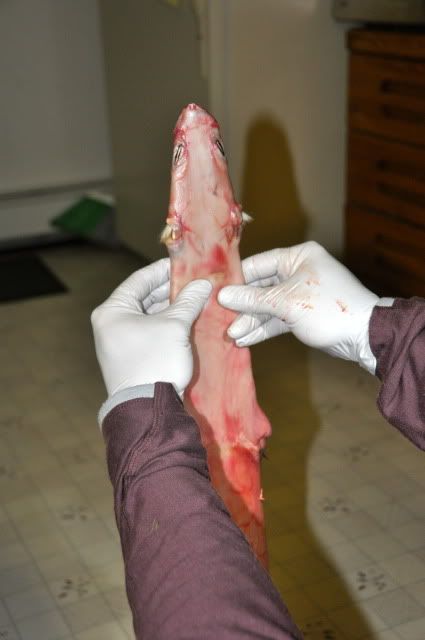
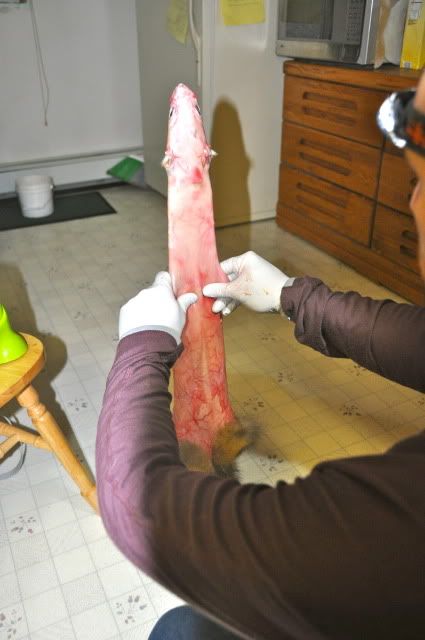
Get some pushpins ready, and when you get to the bottom, pull all the slack you can out and KEEP TENSION on the hide while you start to pin it down. :) I always stretch the tail side of the hide first to get the most out of this back side of the pelt, because it is the one that will be used to size-grade your fur. This is another reason for that 'money cut' mentioned in the beginning.
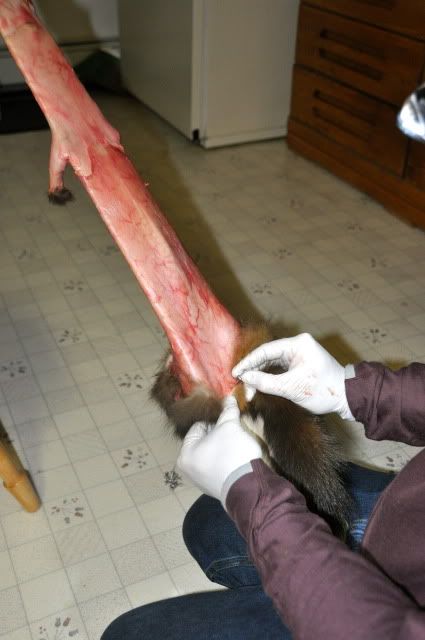
I like to just let the front legs stick out at this stage - when I turn the hide fur-side out, I will tuck in these 'stubs' and they will just remain inside the finished, dried fur.

Once you have a couple pins in there, you can relax a bit on the pulling and let the pins do their job. Add more as necessary to get your fur as even as you can, to improve the presentation. Don't forget pins to spread the tail and rear legs as well, to speed the drying.
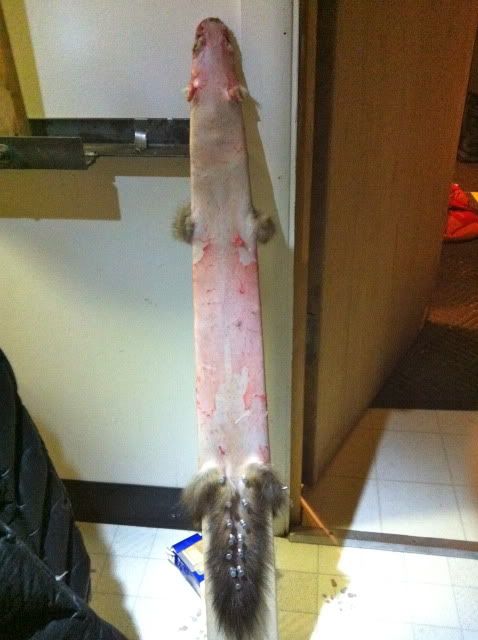
Now is the time, before the pelt dries, to trim all chunks of fat/membrane/tissue off the pelt with your knife. I like to use more pulling than cutting when doing this, and in fact, I purposely use a dull knife for the job. We can still make holes at this point!
Once the pelt has been trimmed, and had time to dry (which will vary greatly depending on weather, temperature and humidity of where you are drying, etc.), it will feel a little like parchment paper, and will even make a dry scratchy sound when you run a fingernail across it. All 'moist' looking areas should be gone at this point, with no visible coagulated fat or beads of oil. Marten are one of the easiest animals to get good and dry, but still....this is important.
That said, now pull the pins and by grabbing the end of the nose, pull the skin off the stretcher. Then tuck the nose down into the center of the fur, basically turning it inside out like a sock. Work the hide bit by bit with your thumbs carefully so as not to tear it. A properly dry pelt will crinkle at this stage, but is not quite so dry that it leaves a crease at a bending point. Too dry means a chance of tearing when turning it right-side out. When the pelt is fully fur-side out, it can be put back on the stretcher, same way, but now the skin side is in of course. Hook the nose on the stretcher end and work your way down towards the tail, straightening and pulling as you go, keeping things centered. Many marten, unless rather dark, will have a stripe of color down the middle of their back which can help somewhat with this. Here is the marten we just skinned, fur-side out and back on the stretcher. Note the stripe I was talking about:
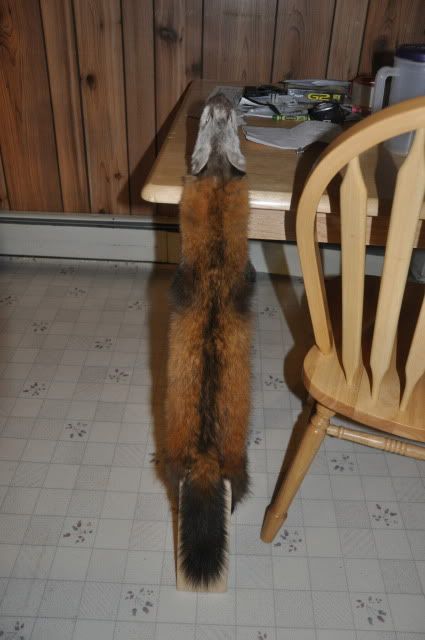
This one was pretty large! Here's how large. Anything 23" long and up from nose to the end of fur on the back side is graded as a 2XL. This guy (a male) was nearly 26" on that measurement! In fact, from nose to tail, he measured an even 35 inches!! One of the biggest Marten I've ever skinned.
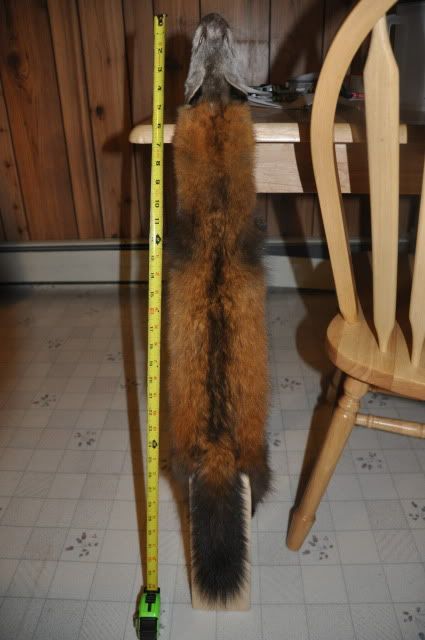
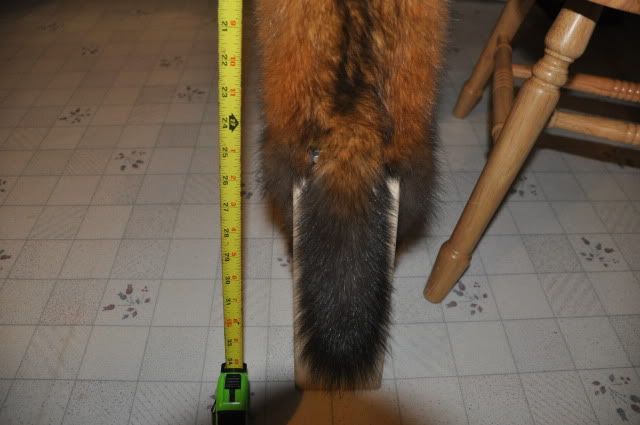
There are many, many, tips and tricks a person will pick up along the way over time regarding pelt handling, including how to cut, how to stretch, how to pin, how to comb, dry, tumble, etc...could go on forever. I am still learning every season, and I won;t go into everything here - but at least I have gotten you to where you can get your marten on the stretcher and dried successfully.

